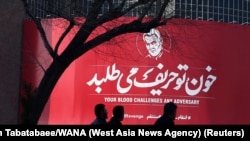Major-General Mohammad-Ali Jafari, the former commander of Iran's Revolutionary Guard shattered the meticulously woven myth of the slain Qods Force Commander Qassem Soleimani as "a nonpartisan figure" by exposing his direct involvement in crackdowns on Iran protesters in 1999 and 2009.
"In the seditions of 1999 and 2009 Haj Qassem was present on the streets to fight the anti-revolutionaries and took measures to control the unrest and riots," Jafari wrote in a rare Twitter post on Sunday and added: "He also used his influence among the elite to enlighten them about political matters amid the dust of these seditions".
What Jafari calls the "1999 sedition" refer to the widespread protests that were sparked by vigilantes' bloody attacks on students peacefully demonstrating on the campus of Tehran University on July 8, 1999 against the closure of a reformist newspaper. One student was killed and many were injured during the attack. At least three more protesters were killed in the following days. Tens of students disappeared after the crackdown on the protesters and more than a thousand were arrested in various cities including Tabriz, Mashhad, Shiraz and Isfahan during the protests.
Soleimani, often referred to as Haj Qassem by his colleagues and supporters, did not openly take sides with any political faction in the past two decades. However, he was one of the signatories of a letter from Guard commanders to reformist President Mohammad Khatami at the height of the 1999 student uprising that effectively threatened a coup against him "if he did not restore order".
The "2009 sedition" is a reference to protests against the highly controversial presidential election results that declared Mahmoud Ahmadinejad, Khamenei's favored candidate the winner. The protests known as Iranian Green Movement began on the night of June 12 following the announcement incumbent Ahmadinejad's victory, were heavy-handedly suppressed by security forces.
The government itself admitted to at least 27 fatalities in Tehran alone and for the first time the Internet was shut down in the country and the signals of satellite television channels based outside the country that reported on the protests were heavily jammed.





